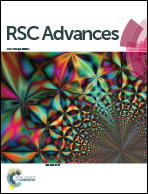Hexagonal hollow silica plate particles with high transmittance under ultraviolet-visible light†
Abstract
Creating hollow structures is one strategy for tuning the optical properties of materials. The current study aimed to increase the optical transmittance of silica (SiO2) particles. To this end, hexagonal-shaped hollow silica plate (HHSP) particles were synthesized from tetraethyl orthosilicate (TEOS) and zinc oxide (ZnO) template particles, using a microwave-assisted hydrothermal method. The size and shell thickness of the HHSP particles could be adjusted by using different TEOS/ZnO molar ratios and different ZnO template sizes, respectively. The optical transmittance of the HHSP particles depended on the shell thickness and particle size. The highest transmittance was 99% in the ultraviolet and visible region (300–800 nm) and was exhibited by HHSP particles with the thinnest shell thickness of 6.3 nm. This transmittance was higher than that exhibited by spherical hollow silica particles with a similar shell thickness. This suggested morphology-dependent transmittance for the semiconducting material. These preliminary results illustrate the promising features of the HHSP particles and suggest their potential application in future transparent devices.



 Please wait while we load your content...
Please wait while we load your content...